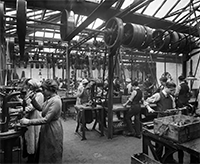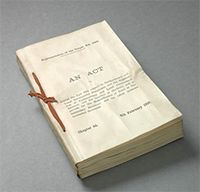The United Kingdom's Representation of the People Act 1918
The Representation of the People Act 1918 was a bill that expanded the voter rolls in the United Kingdom, adding many men and, for the first time, women. 
The primary impetus for expanding the number of men who could vote was the realization that current laws did not allow the men who had survived the horrors of war and made it home to then be able to vote. At the same time, while those men and the other who didn't make it back were away fighting, women stepped up and did many of the jobs that were reserved for men and so many men were convinced that women had earned the right to have the vote. The wartime contributions of women were just the latest in a series of events during which women campaigned for suffrage. Groups like the National Union of Women's Suffrage Societies, led by Millicent Fawcett, and the Women's Social and Political Union, led by the Pankhurst family, employed all manner of strategies to press their case that what they were being denied was a fundamental right.At various times throughout the 19th Century, Parliament had relaxed the conditions for voting. The Reform Act 1832 had expanded the voter rolls by a few hundred thousand, but the number of people who could vote was still a small minority of the overall population. The Reform Act 1867 had added 1.5 million more men to the voter rolls, but it was still only one-third of all eligible males in the population. In effect, the Third Reform Act gave to working men in rural areas the same rights as men living in boroughs. What this meant in practice is that in order to vote, a man had to either own property or rent unfurnished lodgings at the value of £a year. This added another 6 million names to the voters rolls. However, even after this third in what conservatives saw as a series of concessions, the total percentage of men who could vote was still 60 percent. 
The House of Commons passed the Fourth Reform Act in June 1917, by a vote of 385–55. The bill became law by Royal Assent on Feb. 6, 1918. The 1918 bill left only one restriction for males in the U.K.: They had to be at least 21 years old. Another element of the 1918 electoral reform bill was that it designated a day each year on which elections would take place. For the first time, a woman could vote, provided that she was 30 or older and either a property owner herself or the wife of one. All at once, the electorate increased from 8 million to 21 million. Also importantly for women, they could sit in the House of Commons. The first to do so was Nancy Astor, who was elected as the Member of Parliament (MP) for Plymouth Sutton in 1919. |
|
Social Studies for Kids
copyright 2002–2025
David White




